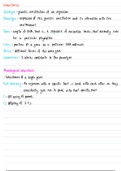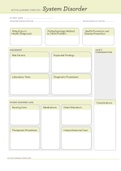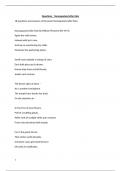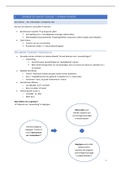Introduction
The microbiome consists of the assembly of microorganisms (prokaryotes, eukaryotes, protozoa,
fungi, algae, and viruses) including their microbial community and structures, metabolites, mobile
genetic elements, and DNA. The microbiome has benefits for human health and is known to play a
role in various diseases as well. The microbiome can be influenced by various characteristics;
geographic location, host genetics, exercise, stress, antibiotics, age, gastric motility, antimicrobial
peptides (IgA), diet, and the mode of delivery. The
microbiome is not only present in the
gastrointestinal tract, but also in the mouth, skin,
and vaginal.
Intestinal physiology: secretion
The function of the intestinal tract consist of four
processes; motility, secretion, absorption and
digestion of carbohydrates, proteins, and fats, and
the absorption of water and ions. We have 9L of
fluid in the intestinal system of which 2L is food.
The other 7L is added by our body itself and these
fluids contain; enzymes, mucus, water, ions,
protons (H+), and HCO3- (bicarbonate). These
fluids need to be reabsorbed again by the small and large intestine. The enzymes are important for
the digestion of our food. We are already digesting food in our mouth using saliva, we can taste
already much more of the components. There are 4 phases of digestion. The cephalic phase
includes the anticipation of food. Already thinking about what you are going to eat makes a reaction
in production of saliva. The oral phase is the phase when the food is located in the mouth. Saliva is
important in both of these phases and is produced by three pairs of salivary glands; parotid gland,
submandibular gland, sublingual gland. Saliva contains water, mucoprotein, and the enzyme
amylase. The importance of saliva is that the food is already diluted to allow taste, is has antimicrobial
effect, but also clean the mouth (a child who does not want to eat does not activate saliva and
therefore the food he eats tastes disgusting). The saliva is produced by two types of secretion; in the
glands (primary) and in the mouth (secondary). The salivary glands secretes additional ions to the
saliva; Na+ that attracts water. In the second secretion besides Na+, also K+ and HCO3- can be
secreted to attract more water. This process is all regulated by tje parasympatic nervous system.
For the oral phase, except from the central nervous system (that regulate long reflexes), also the
reflexes in the intestine (short) and mouth are involved. The intestinal cells contain a pressure
Pagina 1 van 19
,regulator that sense the pressure in the intestine and regulates the reflexes of the flow (motility). The
gastric phase includes the phase when the food goes into the stomach. Many cell types play a role
in this phase:
- parietal cell: production of gastric acid (HCl) and intrinsic factor, which is reponsible for secretion
of vitamine B12
- Mucous neck cell/goblet cell: preparation of you intestinal mucosa by secretion of HCO3- to
protect the mucosa for all acids
- Enterochromaffin-like cell: produces histamine for the release of acetylcholine and gastrin. This
also stimulated the gastric acid secretion
- Chieff cell: production of lipase for lipid digestion and
pepsinogen for the digestion of peptides/protein
- D-cell: production of somatostatin that inhibits the gastric
acid secretion
- G-cell: production of gastrin that stimulated gastric acid
secretion as well.
In the stomach the food is stored for a while (4 hours) to
digest and to make sure you have an entry into the intestinal
system bit by bit. Acetylcholine is a neurotransmitter that
activates the gastric acid secretion. In the cephalic phase;
sensing and production of saliva induces the production of acetylcholine and in the gastric phase the
presence of food in the stomach will stimulate the production of gastrin in the G-cells. Where in the
cephalic phase acetylcholine is the most prominent for acid production, in the gastric phase this is
histamine and gastrin. Hormones not only stimulate the release of gastric acid, but also the
production and activity of the parietal cells are stimulated. In the resting phase everything is in
tubulovesicles inside the cells but in the active phase you get an extension of the membrane so a
larger surface in which the proton channels can secrete. Also the number of parietal cells can
increase. A schematic overview of the stomach digestion is given here. If you have a lot of protons
in the stomach this will induce somatostatin production in the D-cells to induce the negative feedback
loop. The chieff cells are activated by the enteric sensory neurons that are neurons in the gastric
mucosa that activate the chieff cells to release enzymes. Pepsinogen is not an active enzyme, but
is activated by H+ to form pepsine which is active to digest proteins or peptides. The hormones in
the stomach have a very low half-life (short signal) to prevent that you have an over-secretion of H+.
If there is a problem with acid secretion in the stomach this can be treated. Proton pump inhibitors
(omeprazol) that can inhibit the K+ and H+ exchange. Also the histamine receptor can be inhibited
by H2 antagonists (cimitidin), this only partially inhibits acid secretion since the proton pump
Pagina 2 van 19
, inhibitors are still working. Bicarbonate (HCO3-) is a chemical barrier that can neutralize the acid (pH
7).
Ulcers are characterized by damage to the gastric wall or
duodenum and caused by Helicobacter Pilori. You are
more prominent to ulcers when you have a lot of
medication and or alcohol. Ulcers result in bleeding of
the stomach and can be diagnosed by gastroscopy.
The intestinal phase is the last phase, which
regulated by the emptying of the stomach and the
entering of the food in the intestine. The entry of the
food of the stomach into the duodenum is regulated
by the pylorus sphincter that is dependent on the acidity, osmotic
pressure, fat content, and carbohydrates. Then it enters in the
duodenum where most of the digestion takes place by enzymes of
the pancreas. First, after entry, HCO3- is released that will neutralize
the pH. Then you get many secretions in the small intestine. The low
osmolarity of the solution will activate the endocrine cells to produce
enzymes. The presence of carbohydrates will stimulate the release
of gastrin inhibitory peptide (GIP) and glucagon-like peptide 1 (GLP-
1), which are signals to activate insulin secretion to prevent a high
sugar and glucose concentration in the blood. Then the sensing of
proteins causes the secretion of cholecystokinin (CCK), which further
activates the pancreas secretion. In this system many feedback loops are initiated. Many of the
enzymes required for digestion are not directly produced, but there is always a hormone of enzyme
In between. The pancreas has two different cell types producing hormones; endocrine secretion
(glucagon and insulin) to blood and the exocrine enzymes to stimulate digestion. The composition
of this pancreatic juice is first driven by secretion of ions (Na+, K+, Cl-, HCO3-), which will attract
water. In this fluid the enzymes are released. There is thus an exchange of HCO3- and Cl-. In cystic
fibrosis there is a defect in the CFTR that ensures the transport of chloride into the lumen of the
pancreas or intestine. This CFTR is important for the production of the mucous layer because it
ensures water influx into the mucous. This CFTR is present in the lunch, pancreas, and lumen so
you get a very dry mucous. These patients also have a problem with digestion. Also in the intestine
Pagina 3 van 19











